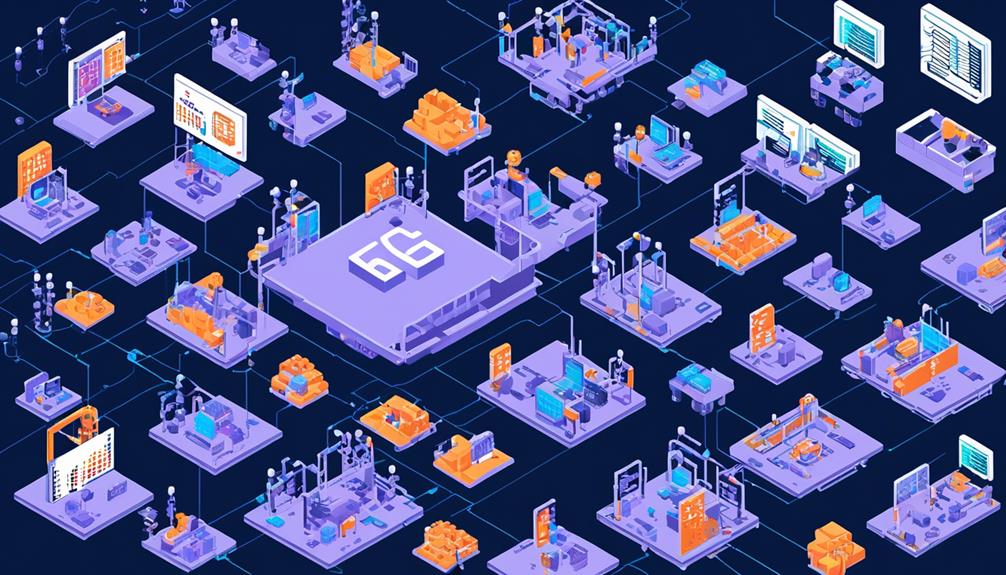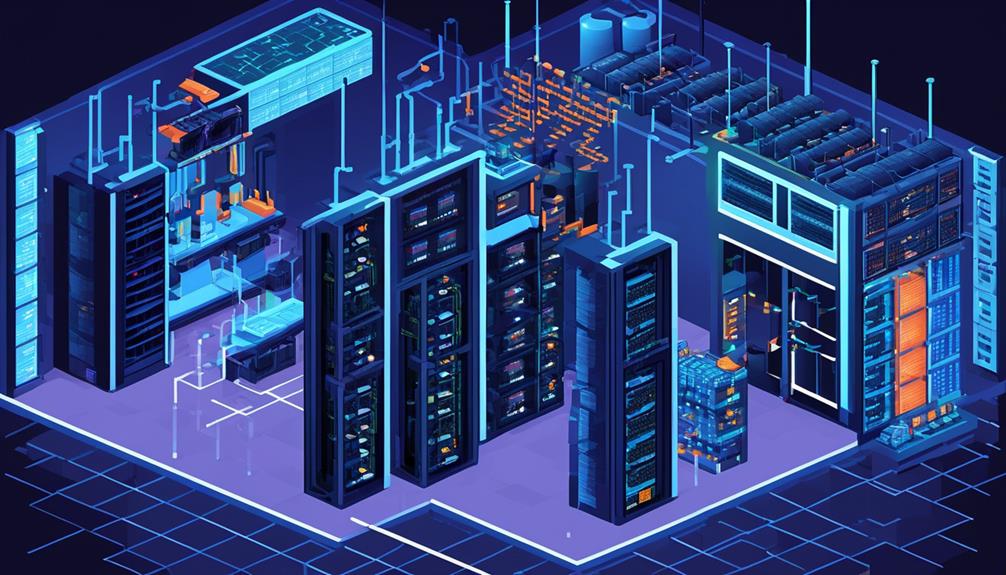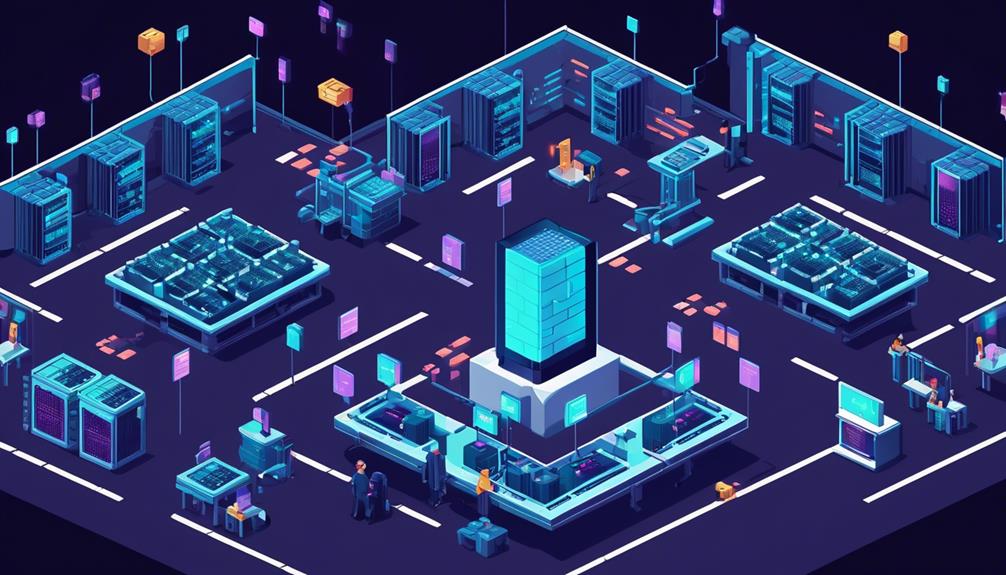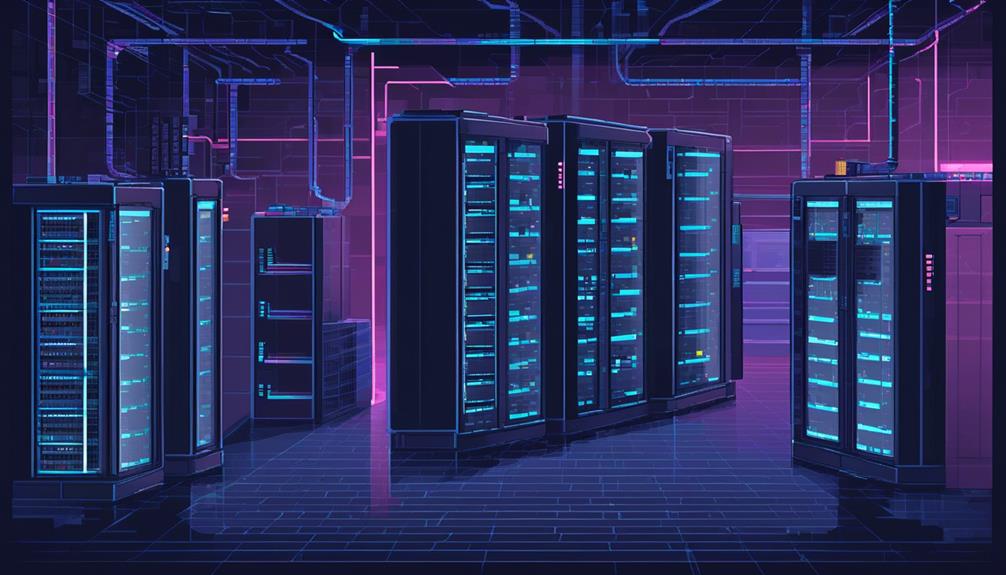As technology continues to evolve, the integration of 5G networks and data center infrastructure becomes an increasingly important topic of discussion. The deployment of 5G networks brings forth a multitude of opportunities and challenges for data centers, requiring them to adapt and optimize their infrastructure to support the high-speed and low-latency capabilities of this next-generation technology.
From the implications of 5G on data center infrastructure to the benefits and challenges of its integration, there are numerous aspects to explore in understanding how data centers can effectively leverage 5G to enhance connectivity and meet the growing demands of modern applications.
In this discussion, we will delve into the various considerations and strategies for successful 5G deployment in data center infrastructure, exploring the implications, benefits, challenges, and hardware optimizations required to ensure seamless connectivity and future-proof operations.
Key Takeaways
- 5G technology will require efficient and scalable data management systems in data centers.
- The adoption of 5G will enable faster data processing, real-time analytics, and personalized services.
- Integrating 5G into data center infrastructure poses challenges such as the need for edge data centers, power consumption optimization, and ensuring security and data privacy.
- To optimize data center infrastructure for 5G, implementing edge data centers, adopting energy-efficient technologies, enhancing security measures, and upgrading cooling systems and power distribution are crucial.
Implications of 5G on DCI

The implications of 5G on data center infrastructure will necessitate a shift towards more efficient and scalable data management, automation, and real-time analytics to support the demands of this advanced technology.
5G technology's high bandwidth and low latency will significantly impact data center infrastructure, enabling faster data processing and real-time analytics. With the growth of 5G networks and edge computing, data center infrastructure will need to adapt to handle the increased volume and speed of data transmission.
One of the key implications of 5G on data center infrastructure is the need for more efficient data management. The higher bandwidth and lower latency of 5G will result in a massive increase in data traffic, requiring data centers to handle larger volumes of data at faster speeds. To meet this demand, data centers will need to implement more efficient data management systems that can handle the increased workload and ensure optimal performance.
Automation will also play a crucial role in the implications of 5G on data center infrastructure. With the higher speeds and lower latencies of 5G, data centers will need to automate various processes to ensure efficient operation and minimize human error. Automation can help streamline tasks such as data backup, server management, and network monitoring, allowing data centers to operate more efficiently and effectively.
Real-time analytics will become increasingly important in the context of 5G and data center infrastructure. The low latency of 5G networks will enable data centers to analyze data in real-time, allowing for faster decision-making and more effective resource allocation. Real-time analytics can help data centers identify and address any issues or bottlenecks in their infrastructure, ensuring optimal performance and minimizing downtime.
Benefits of 5G for Data Centers
Enhancing data center operations, 5G brings faster and more reliable wireless connectivity, facilitating efficient and responsive data processing. The benefits of 5G for data centers are numerous and impactful. Here are three key advantages:
- Support for Edge Computing:
The low latency of 5G technology enables real-time data processing and analytics, making it ideal for edge computing. Edge computing allows data centers to process and store data closer to end-users, reducing latency and improving user experience. With 5G, data centers can deliver faster and more personalized services, enabling real-time decision-making and enhancing overall operational efficiency.
- Improved Data Center Infrastructure Management (DCIM):
5G supports seamless connectivity and communication between data centers, facilitating distributed cloud computing. This enhances data center scalability and flexibility, allowing for efficient resource allocation and workload management across multiple locations. With 5G, data centers can optimize their infrastructure, ensuring high availability and better utilization of resources.
- Energy Efficiency:
The high bandwidth capacity of 5G enables data centers to efficiently handle the growing volumes of data generated by emerging technologies like IoT, AI, and big data analytics. By processing and storing data locally at the edge, data centers can reduce the need for data transfers to central facilities, resulting in lower energy consumption. 5G's energy efficiency capabilities align with the increasing focus on sustainability in data center operations.
Challenges of 5G Integration in DCI

Integrating 5G into data center infrastructure presents significant challenges due to increased network complexity and capacity demands. The advent of 5G technology brings with it the need for ultra-low latency and high bandwidth, which raises concerns about meeting the performance requirements within data centers. To support the new technology's demands, significant upgrades to existing data center networks and infrastructure are necessary.
One of the major challenges in integrating 5G into data centers is the need for edge data centers. These are decentralized data centers located closer to the end-users, enabling faster data processing and reduced latency. The deployment of edge data centers requires careful consideration of their placement and connectivity to ensure efficient and reliable 5G service delivery.
Another challenge is the impact of 5G on cloud computing. The increased capacity demands of 5G require data centers to have scalable and flexible cloud infrastructure. Data centers must adapt to handle the massive influx of data generated by 5G devices and applications, which can strain existing cloud resources.
Power consumption is also a significant concern when integrating 5G into data center infrastructure. 5G networks require more power to support the increased data processing and transmission capabilities. Data centers must find ways to optimize power usage and implement energy-efficient solutions to minimize the environmental impact and operational costs associated with 5G integration.
Furthermore, security concerns pose a challenge when integrating 5G into data center infrastructure. Protecting against potential cyber threats and ensuring data privacy within data centers become crucial tasks. Interoperability between 5G networks and existing data center infrastructure adds complexity that needs to be carefully managed to maintain a secure and robust data environment.
Optimizing DCI for 5G Technology
To effectively support the demands of 5G technology, optimizing Data Center Infrastructure (DCI) requires a strategic approach that encompasses various aspects of data center management.
Here are three key strategies for optimizing DCI for 5G technology:
- Implementing edge data centers: With 5G applications requiring ultra-low latency, deploying edge data centers closer to the end-users becomes essential. These localized data centers reduce the distance between users and the data processing infrastructure, minimizing latency and improving overall performance.
- Leveraging energy-efficient technologies and renewable energy sources: The high energy demands of 5G data centers necessitate the adoption of energy-efficient technologies. Implementing advanced cooling systems, optimized power distribution, and renewable energy sources not only reduces operational costs but also aligns with the increasing demand for sustainable practices.
- Enhancing security measures: As 5G networks transmit vast amounts of sensitive data, enhancing security measures is paramount. Robust physical security systems, including surveillance cameras and access control systems, must be implemented to safeguard the physical infrastructure. Additionally, encryption protocols and advanced cybersecurity measures should be employed to protect data integrity and confidentiality.
Future-proofing DCI for 5G

Future-proofing Data Center Infrastructure (DCI) for 5G necessitates implementing robust infrastructure products and efficient data management solutions to meet the increased demand for real-time analytics, monitoring, and scalability. The advent of 5G technology brings about a surge in data storage and processing requirements, driven by the proliferation of cloud computing, big data analytics, artificial intelligence (AI), and the Internet of Things (IoT).
To ensure that DCI is ready to handle this exponential growth, it is crucial to consider the shift towards edge computing. The rise of IoT devices and 5G networks underscores the need for efficient data processing and connectivity solutions within data centers to support edge computing requirements.
Future-proofing DCI for 5G also entails incorporating energy-efficient and sustainable practices. As data centers become increasingly power-hungry, it is essential to adopt energy-efficient technologies, such as advanced cooling systems and virtualization, to minimize energy consumption. Furthermore, utilizing renewable energy sources to power data centers plays a vital role in environmental sustainability.
Security measures are another key aspect of future-proofing DCI for 5G. With the growing reliance on data centers, protecting sensitive information and ensuring uninterrupted operation are paramount. Physical security measures, such as restricted access and surveillance systems, should be implemented to safeguard against unauthorized entry. Intrusion detection systems, data encryption, and redundant backups are essential to prevent data breaches and ensure business continuity.
5G's Impact on Data Center Infrastructure Hardware
The impact of 5G on data center infrastructure hardware is characterized by the increasing demand for high-performance servers and storage systems. This is driven by the surge in data storage and processing requirements brought about by cloud computing, big data analytics, artificial intelligence (AI), and the Internet of Things (IoT).
To meet these demands, data center infrastructure hardware must evolve to provide robust and scalable solutions. Here are three key aspects of the impact of 5G on data center infrastructure hardware:
- Proliferation of Edge Computing: The growth of edge computing has led to the need for efficient and powerful hardware solutions. Edge computing enables faster and more localized data processing by bringing computational capabilities closer to the data source. This requires data centers to deploy hardware that can handle the increased workload and deliver low-latency performance.
- Energy Efficiency: As the focus on energy efficiency in data centers continues to grow, there is a demand for hardware solutions designed for optimal power usage and thermal management. These solutions aim to minimize energy consumption and reduce the environmental impact of data center operations. Efficient hardware designs and technologies, such as liquid cooling and efficient power supplies, are being adopted to address these concerns.
- Adoption of Innovative Technologies: The impact of 5G also includes the adoption of innovative hardware technologies to support real-time analytics, automation, and efficient data management in data center infrastructure. For example, the use of solid-state drives (SSDs) instead of traditional hard disk drives (HDDs) can significantly improve data access and processing speeds, enhancing overall system performance.
Enhancing Connectivity With 5G in Data Centers

Enhancing connectivity with 5G in data centers brings several advantages to network performance and data transmission.
With the implementation of 5G technology, data centers can achieve faster and more efficient data transmission, enabling real-time processing and analysis.
This improvement in network performance contributes to overall operational scalability and responsiveness, meeting the demands of data-intensive applications and supporting emerging technologies like IoT and AI.
Improved Network Performance
Implementing 5G technology in data centers revolutionizes network performance, enabling faster connectivity, reduced latency, and enhanced data processing capabilities. This advancement in network performance brings several benefits to data center infrastructure:
- Increased Efficiency: With 5G, data centers can process and store data more efficiently, leading to improved overall performance. This technology allows for faster data transfer rates, enabling quicker access to critical information.
- Higher Capacity: 5G connectivity provides higher network capacity and bandwidth, which is essential for meeting the growing demand for data-intensive operations in data centers. It supports the seamless integration of technologies like cloud computing, big data analytics, AI, and IoT applications.
- Improved Reliability: The implementation of 5G technology in data centers enhances overall network reliability. This reliability is crucial for ensuring uninterrupted operations and meeting the evolving demands of modern data-intensive applications.
Faster Data Transmission
Building upon the advancements in network performance, the implementation of 5G technology in data centers takes connectivity to new heights, specifically in terms of faster data transmission. This means reduced latency and enhanced speeds, enabling data centers to handle larger volumes of data with greater efficiency. With 5G connectivity, data centers can support real-time analytics, Internet of Things (IoT), and Artificial Intelligence (AI) applications, allowing for faster processing and storage capabilities. Moreover, 5G in data centers facilitates quicker access to cloud-based services, enabling seamless integration with edge computing and reducing network congestion. The adoption of 5G technology in data centers opens up possibilities for innovative applications and services, driving industry growth and paving the way for technological breakthroughs.
| Advantages of 5G in Data Centers |
|---|
| Faster data transmission |
| Reduced latency |
| Enhanced connectivity |
| Support for real-time analytics |
Strategies for Successful 5G Deployment in DCI
To ensure successful deployment of 5G in data center infrastructure (DCI), organizations must address several key challenges and meet specific infrastructure requirements.
These challenges include upgrading networking equipment, storage systems, and power infrastructure to handle the increased demands of 5G technology.
Additionally, efficient cooling systems and energy consumption technologies are essential to accommodate the higher energy needs of 5G networks.
Deployment Challenges
Deploying 5G in data center infrastructure presents various challenges, including increased network complexity and higher data processing demands. To overcome these challenges, organizations need to implement strategies that optimize network architecture and enable efficient resource allocation.
Here are three key strategies for successful 5G deployment in data center infrastructure:
- Network slicing: Implementing advanced network slicing allows for the creation of virtual networks within the physical infrastructure, enabling efficient management and allocation of resources based on specific application requirements.
- Robust security measures: To safeguard data in a 5G-enabled environment, organizations must adopt robust security measures such as encryption and intrusion detection systems. This ensures the confidentiality and integrity of data within the data center infrastructure.
- Spectrum management and interference mitigation: Effective spectrum management and interference mitigation techniques are crucial in successfully deploying 5G in data centers. These strategies help optimize the use of available frequency bands and minimize interference, ensuring reliable and high-quality connectivity.
Infrastructure Requirements
With the deployment challenges of 5G in data center infrastructure addressed, the focus now shifts to the essential infrastructure requirements for successful implementation of this revolutionary technology.
Data center infrastructure must be equipped with robust networking equipment and storage systems capable of supporting high-speed data processing.
Additionally, efficient cooling systems and power infrastructure are necessary to meet the increased energy demands of 5G networks.
Security measures such as data encryption and intrusion detection systems are essential for protecting sensitive 5G network data within the data center infrastructure.
Moreover, investing in edge computing can reduce latency and provide opportunities for optimizing 5G networks.
Frequently Asked Questions
What Are the 3 Main Components of a Data Center Infrastructure?
The three main components of a data center infrastructure are:
- Data center architecture: This refers to the physical layout and design of the data center. It includes the arrangement of servers, storage systems, and cooling systems. The goal is to create an efficient and effective layout that optimizes space and allows for easy maintenance and scalability.
- Network design: This component involves the configuration of networking equipment in the data center. The aim is to ensure efficient communication and connectivity between devices. This includes setting up routers, switches, and firewalls to enable fast and reliable data transmission.
- Power management: Power management entails the provision and management of electricity to all components in the data center. It includes ensuring a stable power supply, as well as implementing backup power systems to ensure uninterrupted operation in case of power outages. This is crucial to prevent data loss and downtime.
Having these three components well-designed and properly implemented is essential for a data center to function effectively and meet the demands of modern IT infrastructure.
What Are the Five Core Elements of the Data Center Infrastructure?
The five core elements of a data center infrastructure encompass scalability challenges, energy efficiency, and security measures.
Scalability is imperative to accommodate the growing demand for data storage and processing capabilities.
Energy efficiency focuses on optimizing power consumption and reducing environmental impact.
Security measures aim to protect data from unauthorized access, ensuring confidentiality and integrity.
These core elements are fundamental in designing and operating a modern data center infrastructure that can meet the evolving needs of businesses and organizations.
What Are the Three Main Types of Data Centers?
The three main types of data centers are:
- Enterprise data centers: These are owned and operated by a single organization to meet their IT needs. They are typically located on-site and are dedicated to supporting the organization's specific requirements.
- Colocation data centers: These data centers provide space for multiple organizations to rent and house their servers and IT infrastructure. In a colocation data center, each organization has its own dedicated space, power, and cooling resources. This allows organizations to have more control over their infrastructure while benefiting from shared facilities and services.
- Cloud data centers: Managed by cloud service providers, cloud data centers offer computing resources and services over the internet. They are designed to be highly scalable and flexible, providing on-demand access to virtualized computing resources, storage, and applications. Cloud data centers allow organizations to quickly and easily scale their infrastructure as needed, reducing the need for upfront investment in hardware and maintenance.
Each type of data center has its own unique features and advantages, catering to different business requirements.
What Is Data Center in Gcp?
A data center in GCP refers to the infrastructure and services provided by Google Cloud Platform for storing, managing, and processing large amounts of data.
It encompasses various components such as servers, networking equipment, storage systems, and cooling systems to ensure efficient data processing and storage.
GCP data centers are designed with robust security measures to protect sensitive data, comprehensive management tools to monitor and optimize performance, and scalable infrastructure to meet the evolving needs of businesses.

